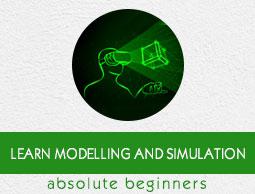Modelling & Simulation - Introduction
Modelling is the process of representing a model which includes its construction and working. This model is similar to a real system, which helps the analyst predict the effect of changes to the system. In other words, modelling is creating a model which represents a system including their properties. It is an act of building a model.
Simulation of a system is the operation of a model in terms of time or space, which helps analyze the performance of an existing or a proposed system. In other words, simulation is the process of using a model to study the performance of a system. It is an act of using a model for simulation.
History of Simulation
The historical perspective of simulation is as enumerated in a chronological order.
1940 − A method named ‘Monte Carlo’ was developed by researchers (John von Neumann, Stanislaw Ulan, Edward Teller, Herman Kahn) and physicists working on a Manhattan project to study neutron scattering.
1960 − The first special-purpose simulation languages were developed, such as SIMSCRIPT by Harry Markowitz at the RAND Corporation.
1970 − During this period, research was initiated on mathematical foundations of simulation.
1980 − During this period, PC-based simulation software, graphical user interfaces and object-oriented programming were developed.
1990 − During this period, web-based simulation, fancy animated graphics, simulation-based optimization, Markov-chain Monte Carlo methods were developed.
Developing Simulation Models
Simulation models consist of the following components: system entities, input variables, performance measures, and functional relationships. Following are the steps to develop a simulation model.
Step 1 − Identify the problem with an existing system or set requirements of a proposed system.
Step 2 − Design the problem while taking care of the existing system factors and limitations.
Step 3 − Collect and start processing the system data, observing its performance and result.
Step 4 − Develop the model using network diagrams and verify it using various verifications techniques.
Step 5 − Validate the model by comparing its performance under various conditions with the real system.
Step 6 − Create a document of the model for future use, which includes objectives, assumptions, input variables and performance in detail.
Step 7 − Select an appropriate experimental design as per requirement.
Step 8 − Induce experimental conditions on the model and observe the result.
Performing Simulation Analysis
Following are the steps to perform simulation analysis.
Step 1 − Prepare a problem statement.
Step 2 − Choose input variables and create entities for the simulation process. There are two types of variables - decision variables and uncontrollable variables. Decision variables are controlled by the programmer, whereas uncontrollable variables are the random variables.
Step 3 − Create constraints on the decision variables by assigning it to the simulation process.
Step 4 − Determine the output variables.
Step 5 − Collect data from the real-life system to input into the simulation.
Step 6 − Develop a flowchart showing the progress of the simulation process.
Step 7 − Choose an appropriate simulation software to run the model.
Step 8 − Verify the simulation model by comparing its result with the real-time system.
Step 9 − Perform an experiment on the model by changing the variable values to find the best solution.
Step 10 − Finally, apply these results into the real-time system.
Modelling & Simulation ─ Advantages
Following are the advantages of using Modelling and Simulation −
Easy to understand − Allows to understand how the system really operates without working on real-time systems.
Easy to test − Allows to make changes into the system and their effect on the output without working on real-time systems.
Easy to upgrade − Allows to determine the system requirements by applying different configurations.
Easy to identifying constraints − Allows to perform bottleneck analysis that causes delay in the work process, information, etc.
Easy to diagnose problems − Certain systems are so complex that it is not easy to understand their interaction at a time. However, Modelling & Simulation allows to understand all the interactions and analyze their effect. Additionally, new policies, operations, and procedures can be explored without affecting the real system.
Modelling & Simulation ─ Disadvantages
Following are the disadvantages of using Modelling and Simulation −
Designing a model is an art which requires domain knowledge, training and experience.
Operations are performed on the system using random number, hence difficult to predict the result.
Simulation requires manpower and it is a time-consuming process.
Simulation results are difficult to translate. It requires experts to understand.
Simulation process is expensive.
Modelling & Simulation ─ Application Areas
Modelling & Simulation can be applied to the following areas − Military applications, training & support, designing semiconductors, telecommunications, civil engineering designs & presentations, and E-business models.
Additionally, it is used to study the internal structure of a complex system such as the biological system. It is used while optimizing the system design such as routing algorithm, assembly line, etc. It is used to test new designs and policies. It is used to verify analytic solutions.


